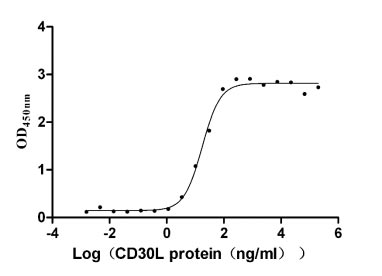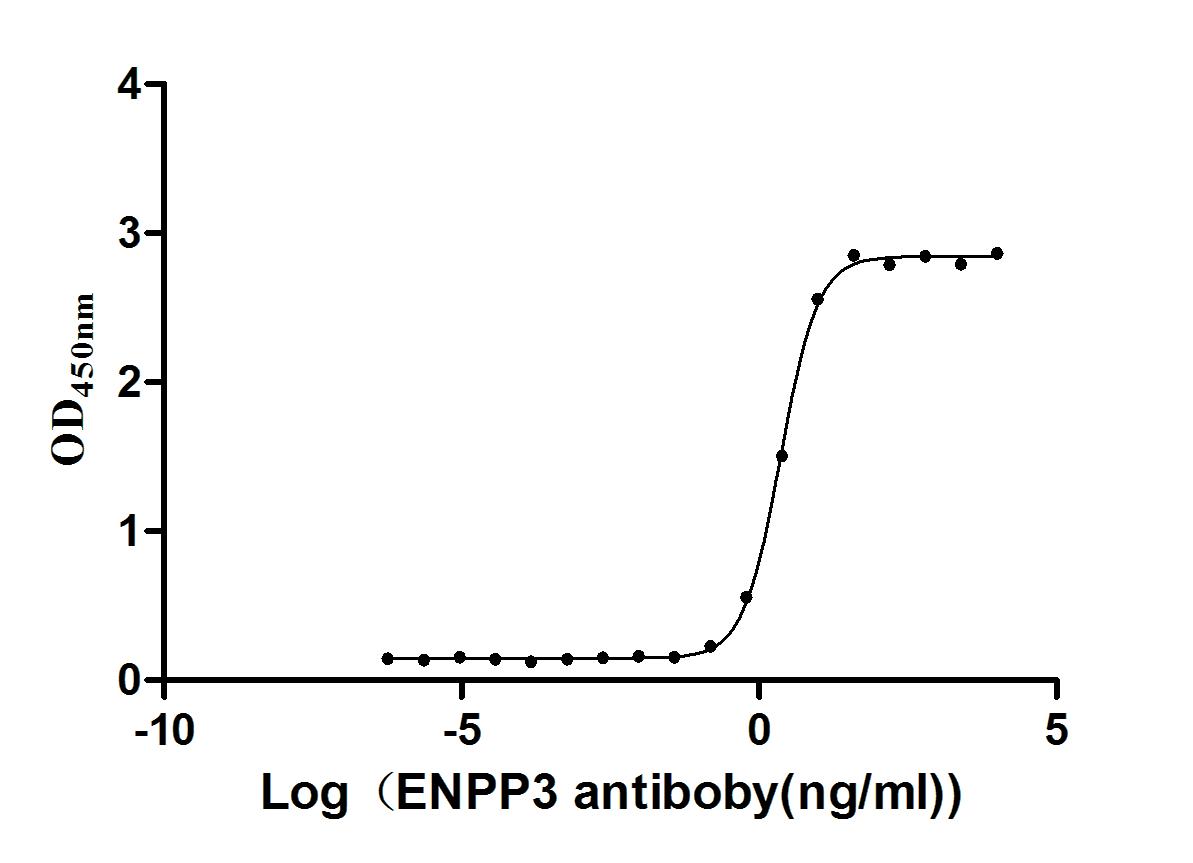Recombinant Human Serine/threonine-protein kinase MAK (MAK)
-
货号:CSB-YP013369HU
-
规格:
-
来源:Yeast
-
其他:
-
货号:CSB-EP013369HU
-
规格:
-
来源:E.coli
-
其他:
-
货号:CSB-EP013369HU-B
-
规格:
-
来源:E.coli
-
共轭:Avi-tag Biotinylated
E. coli biotin ligase (BirA) is highly specific in covalently attaching biotin to the 15 amino acid AviTag peptide. This recombinant protein was biotinylated in vivo by AviTag-BirA technology, which method is BriA catalyzes amide linkage between the biotin and the specific lysine of the AviTag.
-
其他:
-
货号:CSB-BP013369HU
-
规格:
-
来源:Baculovirus
-
其他:
-
货号:CSB-MP013369HU
-
规格:
-
来源:Mammalian cell
-
其他:
产品详情
-
纯度:>85% (SDS-PAGE)
-
基因名:MAK
-
Uniprot No.:
-
别名:MAKSerine/threonine-protein kinase MAK; EC 2.7.11.1; Male germ cell-associated kinase
-
种属:Homo sapiens (Human)
-
蛋白长度:Full length protein
-
表达区域:1-623
-
氨基酸序列MNRYTTMRQL GDGTYGSVLM GKSNESGELV AIKRMKRKFY SWDECMNLRE VKSLKKLNHA NVIKLKEVIR ENDHLYFIFE YMKENLYQLM KDRNKLFPES VIRNIMYQIL QGLAFIHKHG FFHRDMKPEN LLCMGPELVK IADFGLAREL RSQPPYTDYV STRWYRAPEV LLRSSVYSSP IDVWAVGSIM AELYMLRPLF PGTSEVDEIF KICQVLGTPK KSDWPEGYQL ASSMNFRFPQ CVPINLKTLI PNASNEAIQL MTEMLNWDPK KRPTASQALK HPYFQVGQVL GPSSNHLESK QSLNKQLQPL ESKPSLVEVE PKPLPDIIDQ VVGQPQPKTS QQPLQPIQPP QNLSVQQPPK QQSQEKPPQT LFPSIVKNMP TKPNGTLSHK SGRRRWGQTI FKSGDSWEEL EDYDFGASHS KKPSMGVFKE KRKKDSPFRL PEPVPSGSNH STGENKSLPA VTSLKSDSEL STAPTSKQYY LKQSRYLPGV NPKKVSLIAS GKEINPHTWS NQLFPKSLGP VGAELAFKRS NAGNLGSYAT YNQSGYIPSF LKKEVQSAGQ RIHLAPLNAT ASEYTWNTKT GRGQFSGRTY NPTAKNLNIV NRAQPIPSVH GRTDWVAKYG GHR
-
蛋白标签:Tag type will be determined during the manufacturing process.
The tag type will be determined during production process. If you have specified tag type, please tell us and we will develop the specified tag preferentially. -
产品提供形式:Lyophilized powder
Note: We will preferentially ship the format that we have in stock, however, if you have any special requirement for the format, please remark your requirement when placing the order, we will prepare according to your demand. -
复溶:We recommend that this vial be briefly centrifuged prior to opening to bring the contents to the bottom. Please reconstitute protein in deionized sterile water to a concentration of 0.1-1.0 mg/mL.We recommend to add 5-50% of glycerol (final concentration) and aliquot for long-term storage at -20℃/-80℃. Our default final concentration of glycerol is 50%. Customers could use it as reference.
-
储存条件:Store at -20°C/-80°C upon receipt, aliquoting is necessary for mutiple use. Avoid repeated freeze-thaw cycles.
-
保质期:The shelf life is related to many factors, storage state, buffer ingredients, storage temperature and the stability of the protein itself.
Generally, the shelf life of liquid form is 6 months at -20°C/-80°C. The shelf life of lyophilized form is 12 months at -20°C/-80°C. -
货期:Delivery time may differ from different purchasing way or location, please kindly consult your local distributors for specific delivery time.Note: All of our proteins are default shipped with normal blue ice packs, if you request to ship with dry ice, please communicate with us in advance and extra fees will be charged.
-
注意事项:Repeated freezing and thawing is not recommended. Store working aliquots at 4°C for up to one week.
-
Datasheet :Please contact us to get it.
相关产品
靶点详情
-
功能:Essential for the regulation of ciliary length and required for the long-term survival of photoreceptors. Phosphorylates FZR1 in a cell cycle-dependent manner. Plays a role in the transcriptional coactivation of AR. Could play an important function in spermatogenesis. May play a role in chromosomal stability in prostate cancer cells.
-
基因功能参考文献:
- We report the first case of leaking intraretinal cystoid spaces due to mutation in MAK. Mak regulates microtubule stability via phosphorylating RP1. Abnormal Mak may impact retinal photoreceptor ciliary length and subcompartmentalization. PMID: 26894652
- One patient was homozygous for the insertion, one compound heterozygous with a missense change on the other allele (c. 46G>A; p.Gly16Arg), and three were heterozygous carriers. PMID: 26558903
- We identified the MAK and DHDDS mutations homozygously in only 2.1% and 0.8%, respectively, of patients of mixed ethnicity, but in 25.7% and 8.6%, respectively, of cases reporting Jewish ancestry PMID: 25255364
- Nonsense and missense mutations in MAK give rise to a non-syndromic recessive RP phenotype without apparent extra-ocular features. PMID: 25385675
- the expressions of ICK/MAK/MOK proteins in the intestinal tract can be differentially and dynamically regulated, implicating a significant functional diversity within this group of protein kinases. PMID: 24244486
- In glioblastoma cells with deregulated high levels of CCRK, its depletion restores cilia through ICK and an ICK-related kinase MAK, thereby inhibiting glioblastoma cell proliferation. PMID: 23743448
- these data implicate MAK in both adrogen receptor activation and chromosomal instability, acting in both early and late prostate cancer development. PMID: 21986944
- The patterns of disease expression in the MAK form of arRP showed some resemblance to patterns described in autosomal dominant RP, especially the form caused by RP1 mutations. PMID: 22110072
- Exome sequencing to identify a homozygous Alu insertion in exon 9 of male germ cell-associated kinase (MAK) as the cause of disease in an isolated individual with retinitis pigmentosa. PMID: 21825139
- Exome sequencing combined with this approach identified a homozygous nonsense mutation in male germ cell-associated kinase (MAK) in the single affected member of a consanguineous Turkish family with retinitis pigmentosa. PMID: 21835304
- identification and transcriptional activation by androgen in prostate cancer cells PMID: 12084720
- MAK plays a general role in androgen receptor(AR) function in prostate cancer cells and is likely to be a general coactivator of AR in prostate tissues. PMID: 16951154
- MRK phosphorylates Scythe at T1080 in vitro as determined by site-directed mutagenesis and mass spectrometry, supporting the consensus and suggesting Scythe as a physiological substrate for MRK. PMID: 16954377
显示更多
收起更多
-
相关疾病:Retinitis pigmentosa 62 (RP62)
-
亚细胞定位:Nucleus. Cytoplasm, cytoskeleton, microtubule organizing center, centrosome. Cytoplasm, cytoskeleton, spindle. Midbody. Cell projection, cilium, photoreceptor outer segment. Photoreceptor inner segment.
-
蛋白家族:Protein kinase superfamily, CMGC Ser/Thr protein kinase family, CDC2/CDKX subfamily
-
组织特异性:Expressed in prostate cancer cell lines at generally higher levels than in normal prostate epithelial cell lines. Isoform 1 is expressed in kidney, testis, lung, trachea, and retina. Isoform 2 is retina-specific where it is expressed in rod and cone photo
-
数据库链接:
HGNC: 6816
OMIM: 154235
KEGG: hsa:4117
STRING: 9606.ENSP00000313021
UniGene: Hs.446125
Most popular with customers
-
Recombinant Human Tumor necrosis factor receptor superfamily member 8 (TNFRSF8), partial (Active)
Express system: Mammalian cell
Species: Homo sapiens (Human)
-
Recombinant Human T-cell surface protein tactile (CD96), partial (Active)
Express system: Mammalian cell
Species: Homo sapiens (Human)
-
Recombinant Human C-X-C chemokine receptor type 4 (CXCR4)-VLPs (Active)
Express system: Mammalian cell
Species: Homo sapiens (Human)
-
Recombinant Mouse Retinol-binding protein 4 (Rbp4) (Active)
Express system: Mammalian cell
Species: Mus musculus (Mouse)
-
Recombinant Dog Angiopoietin-2 (ANGPT2) (Active)
Express system: Mammalian cell
Species: Canis lupus familiaris (Dog) (Canis familiaris)
-
Express system: Mammalian cell
Species: Homo sapiens (Human)
-
Recombinant Human Interleukin-2 (IL2) (Active)
Express system: Mammalian cell
Species: Homo sapiens (Human)
-
Recombinant Human CD70 antigen (CD70), partial (Active)
Express system: Mammalian cell
Species: Homo sapiens (Human)



-AC1.jpg)
-AC1.jpg)















